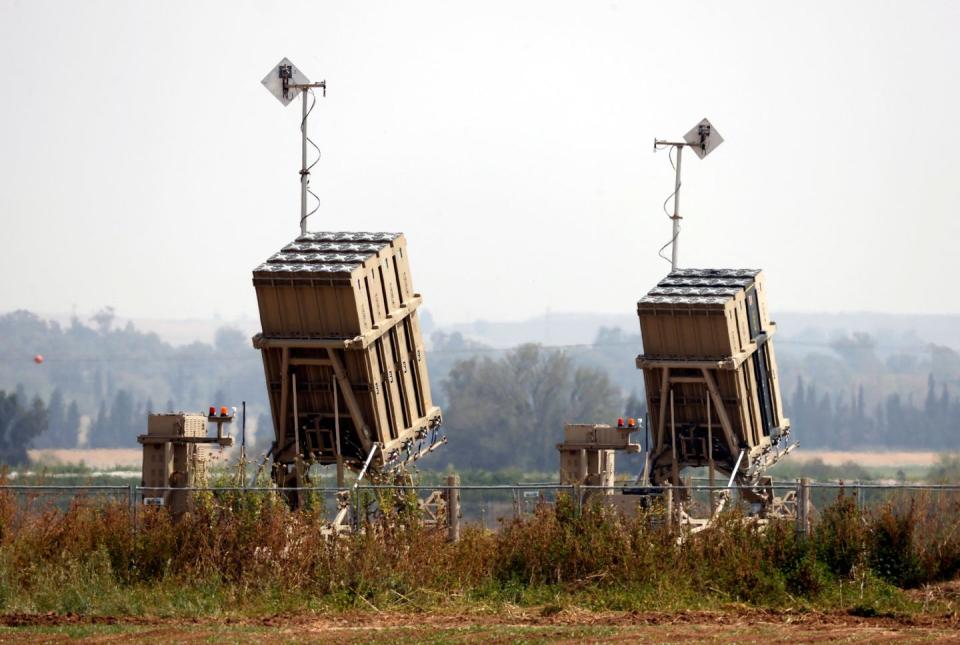Everything You Need to Know About the Iron Dome, Israel's Anti-Rocket Defense System
Israel’s Iron Dome weapon has reportedly shot down most of the rockets that Hamas militants have fired at Israeli neighborhoods during the Israel-Gaza conflict this week.
The Iron Dome is designed to selectively deal with rocket attacks, intercepting only those headed toward populated areas.
Israel claims the Iron Dome is around 90 percent effective, but even a high probability intercept rate can fall victim to sheer numbers.
The ongoing, increasingly deadly fighting between the Palestinian militant group Hamas and the Israel Defense Forces (IDF) has produced dramatic images and videos of Israel’s Iron Dome anti-rocket air defense system shooting down incoming enemy rockets.
➡ Join Pop Mech Pro for exclusive access to the internet’s most elite military tech content.
The Iron Dome, which the United States helped finance, has apparently proven to be 85 to 90 percent effective in shooting the crude rockets that Hamas has fired at Israeli civilian population centers this week, according to the IDF. But a system that shoots down nine out of 10 rockets is less effective when hundreds, or even thousands, of rockets are involved, and the Iron Dome could be overwhelmed by sheer numbers.
Iron Dome working over Tel Aviv after rocket barrages pic.twitter.com/bGHlf9jr7u
— ELINT News (@ELINTNews) May 11, 2021
In a rapid escalation following a local dispute in Jerusalem on Monday, Palestinian militants have fired approximately 1,800 rockets from the Gaza Strip into Israel over the last 3 days, according to the New York Times. Israel has also carried out airstrikes targeting Gaza.
Many of the militant groups operating on Israel’s borders have invested heavily in large arsenals of rockets, which are often descended from Soviet and Chinese Cold War weapons and typically have a diameter of 107 to 122 millimeters. These rockets are usually unguided and armed with a high explosive warhead of 10 pounds or less.
To prepare for conflict with Israel, Hamas and other groups have been digging up the rockets from hidden caches scattered across Gaza and launching them in the direction of an Israeli settlement, town, or city.
While these rockets are inaccurate and poorly aimed, they’re also difficult to detect before launch and fired in large numbers, thus becoming effective weapons. Enter the Iron Dome, which the U.S. government paid Israeli defense contractors Rafael and Israeli Aerospace Industries to develop. Israel first deployed the Iron Dome in 2011, and the country now has 10 total batteries in the network.

A single Iron Dome battery consists of a radar system, battle management system, and three to four missile launch units. The radar is the ELM 2084 advanced electronically scanned array (AESA) radar, which is similar to the type used in modern fighter jets. Each Iron Dome launch unit is armed with up to 20 Tamir interceptor rockets.
According to Raytheon, which is partnering with Rafael to build the Iron Dome in the U.S., each battery can protect an area of 60 square miles.
Here’s how the system works: Once the Iron Dome detects an incoming rocket salvo, it starts tracking the rockets, up to 1,100 at once. As it does, it projects likely impact points and compares that data against known locations of civilian and military targets. When it has this information, the Iron Dome will then decide which rockets to target—but just as important, which rockets not to target. The system won’t engage rockets projected to fall outside population centers.
That sounds like a bug, but it’s actually a feature. Each battery has only 60 to 80 rockets, and each rocket has a hit probability rate that Israel claims is around 90 percent. That’s pretty good, but faced with hundreds of incoming rockets a day, the defenders have to pick and choose which rockets to shoot down and which to pass on. For rockets projected to land in heavily populated areas, the Iron Dome will allocate two Tamir interceptors to ensure the rocket is shot down.
In 2012, according to Air Force magazine, Hamas fired 1,500 rockets from Gaza into Israel. The Iron Dome deemed 500 of those rockets were on threatening trajectories, and engaged them with an 85 percent accuracy rate.
But the problem with the Iron Dome, like any missile or rocket defense system, is that even a high probability intercept rate can fall victim to sheer numbers.
If a militant group like Hamas launches 2,000 rockets and 500 of them are threatening, even an intercept rate of 85 percent will result in 75 rockets landing in populated areas. A system like the Iron Dome must be supplemented with a more active defense system, such as actively hunting missile caches and launchers before they’re used and targeting them with air strikes and artillery.
The Iron Dome is a dome—not an impenetrable shield.
🎥 Now Watch This:
You Might Also Like

